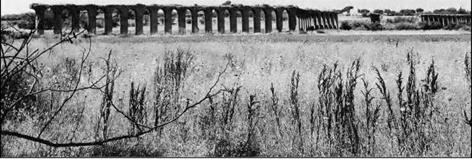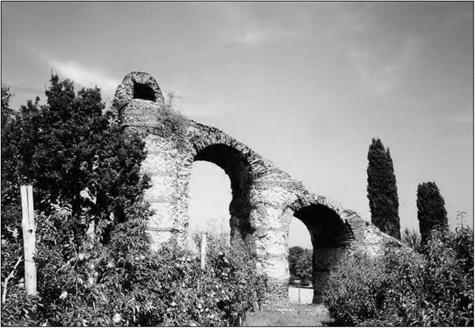Roman hydraulic knowledge and knowledge transfer
An observer of the vast array of Roman technical achievements can only be surprised and disappointed at the lack of technical documentation left by the Romans. With the exception of Vitruvius, whose technical descriptions are sometimes precise (the water mill), and sometimes extremely vague (the aqueducts), there is simply no body of technical literature as we know it. We have extensively cited Frontinus’ book on the aqueducts of Rome, a remarkable work. Yet it is much more of a precise and documented “audit” report than a manual for the guidance of future builders. Pliny’s The Natural History is precious and perhaps an exception, but it has little to do with hydraulic works. It seems that the attitude of the educated Roman leisure class insofar as applied sciences were concerned, tends toward that of the ancient Greeks in retreating from the attitude of the Hellenistic world: the application of knowledge is culturally devalued. Therefore treatises are not written about techniques. It is hard to imagine, for example, such a dearth of technical documentation after the works of Archimedes.
As a consequence, one finds great diversity in the technical solutions found in Roman projects. There are as many exceptionally well conceived works as there are very poorly conceived ones, whether it be in the domain of aqueducts or dams. It is true that in the three largest dams of Spain (Figure 6.29) one sees a certain technical progression, if indeed these dams were built in the order that is thought to be correct. But in the Orient, for example, one finds as many solid and long-lasting retention dams (for example the dams of Homs, and of Harbaqa) as dams whose stability is very problematic, because of an excessive height-to-width ratio.
Another anomaly in the transmission of Roman techniques is visible in the aqueducts that have very large variations of slope from one point to another along their length. The canals in these aqueducts are constructed in anticipation of a constant depth, and yet in steeper segments, the water velocity is greater and, as a consequence, the actual depth of water is less.[295] [296] On the other hand one can see on several aqueducts (at Nimes, for example, but it is not the only one) that, along segments of small slope, the canal walls had to be raised after the initial construction, to prevent overflow. With so many successful projects behind them, how could the Romans not have already experienced this problem and drawn conclusions from it?
Similarly, another problem that has been intriguing to researchers is the Roman evaluation of the discharge of their aqueducts. The quinaria, as we have seen earlier, is a unit of area. It is used by Frontinus as the only reference to determine the quantity of water being delivered. And in Table 6.2 we have, like Frontinus, used a unique equivalence between quinariae and discharges in m3/day. In reality, this equivalence has to be extremely variable. If we consider only several aqueducts of Rome, all having the same slope and the same wall roughness, Table 6.5 shows an important variation, from one aqueduct to the other, of the equivalence between sections (quinariae) and discharges.
|
Table 6.5 Calculation of the discharge of three aqueducts of Rome.92 Variation of discharge corresponding to one quinaria.
|
Were the Romans ignorant of this fact? In reading Frontinus, and in particular the following significant extracts, it would seem that they were not ignorant of it:
“Let us remember that every stream of water, whenever it comes from a higher point and flows into a reservoir after a short run, not only comes up to its measure, but actually yields a surplus; but whenever it comes from a lower point, that is, under less pressure, and is conducted a longer distance, it shrinks in volume, owing to the resistance of its conduit; and that, therefore, on this principle it needs either a check or a help in its discharge.
“But the position of the calix (intake) is also a factor. Placed at right angles and level, it maintains the normal quantity. Set against the current of the water, and sloping downward, it will take in more. If it slopes to one side, so that the water flows by, and if it is inclined with
the current, that is, is less favorably placed for taking in water, it will receive the water slowly and in scant quantity.”[297]
There is both right and wrong in this observation, but in any case there is an intuitive understanding of the importance of the velocity, and even of what hydraulicians today call the ”head”. The importance of the velocity in evaluating the discharge appears even more clearly in this additional extract:
“Whence it appears that the total found by me is none too large. The explanation of this is, that the swifter current of water, coming as it does from a large and rapidly flowing river, increases the volume by its very velocity.”[298]
This intuition as to the importance of the velocity in determining the discharge was not sufficiently strong to be put to use. What has always seemed incomprehensible is the lack of any connection between the knowledge that Frontinus demonstrated – or did not demonstrate – and the work of Heron of Alexandria. We described this work in Chapter 5, and it has long been assumed to have come before Frontinus’ work by at least a century. We now know with certainty that Heron could not have done his writing before 60 AD. Frontinus, while he was studying the aqueducts of Rome, could therefore have been perfectly ignorant of the work of Heron, if indeed that work predated his. It
К
|
Figure 6.39 Remains of the arches of an aqueduct near Rome, between the via Appia Antica and the via Appia Nova (photo by the author). |
is perhaps even possible that it was after having read Frontinus that Heron was led to write down the correct expression for discharge, as the product of the velocity and the cross-sectional area.
One technology that clearly and uniquely represents Roman know-how is the inverse siphon, such as the one that can be seen in the aqueduct of Gier at Lyon. The number of pipes in each siphon is in effect fixed a priori by the size of the head tank,
and by the number of outlet openings in the downstream wall (Figure 6.13). Lacking valves for control of the discharge of the pressurized pipes, one could compensate for dimensioning errors only by plugging one or several of these openings – an expedient visibly employed for certain siphons of the aqueduct of Gier. If the discharge of the pressurized pipes turns out to be too large, causing emptying of the head tank and consequently a dangerous aspiration of air into the siphon, it is thus possible to reduce the discharge. But one has to wonder what expedients were used when, on the contrary, the capacity of the siphon was insufficient, causing the head tank to overflow.
In assessing the technical contributions of the Romans, one must also remember the
|
Figure 6.40. Aqueduct of Gier for Lyon: seen from the upstream end of the siphon of Yzeron, at the place called “le plat de l’air”. From left to right: hidden behind the trees, the arches that support the canal, the remains of the head tank, and the ramp, the inclined plain that carried the lead pipes descending into the valley to the bridge-siphon (photo by the author). |
heritage they received from their predecessors, professors and enemies – the Etruscans. The arch, as well as water supply and drainage works, are part of this heritage. We must also not forget to add to the list of Roman shortcomings their inability to maintain the Etruscan systems for land drainage and maintenance built before them in Italy. In their own country, the Romans allowed so many fertile lands to revert back to swamps, soon infested with malaria – for example the famous Pontin marshes. The lazy urbanites of Rome could have produced wheat on these lands, and relieved somewhat the desperate state of the Egyptian peasants.








Leave a reply